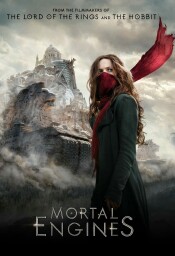Aristotle once paraphrased that “Nature abhors a vacuum,” which is the main thing I keep thinking while watching Mortal Engines, another in a long line of books turned movie adaptations. It seems like everyone is trying to fill the hole left behind by Harry Potter and Twilight (love or hate it, you have to admit that it brought in the teeny boppers) franchises. Unfortunately, I do not see this film becoming a worthy successor to the throne. Initially, I was intrigued by the premise: cities mounted on wheels devouring other cities. It had a real Transformers meets Mad Max vibe to it. If only the film lived up to the preview.
The movie is set in a dystopian world, ravaged by an apocalyptic event known as the “Sixty Minute War”, which caused massive geological upheaval. To escape the destructions cities have installed huge engines and wheels and been enabled to dismantle (or eat) other cities for resources. This act has become known as “Municipal Darwinism”. As a result of the war, much technological and scientific knowledge has been lost. Because scientific progress has almost completely halted, “Old Tech” is highly prized and recovered by scavengers and archaeologists. Europe, some of Asia, North Africa, Antarctica, and the Arctic are dominated by Traction Cities. There is conflict between these cities and a group called the Anti-Traction League, which seeks to keep cities from moving and thus stop the intense consumption of the planet’s remaining resources. That should bring those unfamiliar with the series up to speed regarding the film, which is a better intro than I received while watching the movie.
Getting to the heart of the story, it follows a young woman name Hester Shaw (Hera Hilmar) as she attempts to carry out an assassin plot against Thaddeus Valentine (Hugo Weaving), a prominent in London society who is also responsible for the death of her mother. The attempted murder is thwarted by Tom Natsworthy (Robert Sheehan), an aspiring aviator turned historian, who pursues Hester after she flees. Before escaping, Hester informs Tom as to the kind of man that Valentine is. Upon confronting Valentine with this information, Tom finds himself thrown down the same chute that Hester escaped down.
Meanwhile, the conflict between Traction Cities and the Anti-Traction League is reaching a volatile point as resources to fuel the cities are becoming scarce, and London will need to penetrate the resources behind the Anti-Traction League’s sonic wall if they are to survive. To achieve this objective, Valentine is constructing a weapon that has long been forgotten that has the potential to bring the world to verge of extinction again. To stop him, Hester and Tom will have to put aside their differences and work together.
The film sacrifices story development in favor of a big production budget geared towards special effects. Based on my cursory research into the book series, there was a wealth of detail that could have gone a long way towards establishing this film as a solid opener. As is, I do not see real franchise potential, which is a shame, as I am a big fan of Robert Sheenan, dating all the way back to his run on Misfits. Performance-wise, the film is fine; there was a decent amount of chemistry between the lead characters, and of course Hugo Weaving was a big draw for the film. The most notable performance in my opinion was Jihae as Fang. She was a woman of few words and not afraid to spill blood for the cause that she believed in and the people she cared about. I found her to be an engaging and intriguing presence on the screen, a solid opening for the actress.
I can’t help but feel sad about the wasted potential; the story was too convoluted, and time was wasted on unnecessary characters. Additionally, the alterations away from the source material is unlikely to endear the film to fans of the book. As I said earlier, this was an obvious money grab in order to capitalize on the younger masses and purveyors of adaptation films. Gino compared it to Star Wars, and in truth there are several similarities that will be hard for the audience not to see. However, these elements are better depicted in Star Wars.
In conclusion, the audience like me will likely walk away from Mortal Engines with a sense of disappointment for what could have been, if only the proper amount of time was invested in the story development. I would also be genuinely surprised to see the film win the weekend, as viewers will quickly deduce that the film is all fireworks and very little substance.



